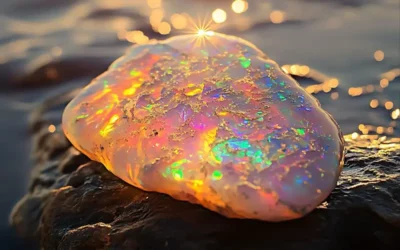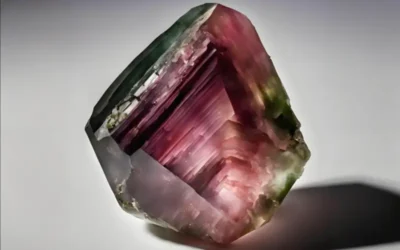October is a month filled with vibrant colors, cool breezes, and a sense of transition from the warmth of summer to the crispness of fall. It’s no surprise that October’s birthstones—opal and tourmaline—perfectly reflect this change. These two gemstones each bring their own unique beauty and symbolism, making them a fantastic choice for October-born individuals or anyone looking for a meaningful and stunning addition to their jewelry collection. Whether you’re considering a special gift or simply admiring the allure of these gems, this guide will dive into everything you need to know about the October birthstones, their meanings, and how you can incorporate them into your jewelry.
Unlike many months that are associated with a single gemstone, October stands out with two beautiful birthstones: opal and tourmaline. Both gems bring their own charm, with opal offering an iridescent play of colors, and tourmaline presenting a spectrum of hues that can captivate any gemstone enthusiast. Together, they capture the spirit of the month: multifaceted, colorful, and full of depth. In this guide, we’ll explore both opal and tourmaline in detail, highlighting their characteristics, symbolism, and the best ways to wear them.
Opal: The Queen of Gems
What Is Opal?
Opal is often referred to as the “Queen of Gems” because of its dazzling appearance and unique structure. Unlike most gemstones, opal is a mineraloid, meaning it lacks a defined crystalline structure. This gives opal its distinct ability to display a play-of-color—a shifting kaleidoscope of colors that can seem to change depending on the angle of light.
Opals are primarily composed of silica and water, with their internal structure arranged in a way that diffracts light, creating the stunning visual effect that makes opals so sought after. This play-of-color can feature a stunning variety of hues, from fiery reds to soft blues and greens, and even rainbow-like flashes.
Types of Opal
Opal is a gemstone with many variations, each with its own distinctive features. Here’s a breakdown of the most well-known types of opals:
- White Opal: Characterized by a light, pale body color with vibrant flashes of color, white opals are among the most common and affordable types of opals. They offer a soft, pastel-like palette of blues, greens, and pinks.
- Black Opal: Considered one of the most valuable opals, black opals have a dark body color, which makes the play-of-color appear even more vibrant and pronounced. Their colors can range from deep blues and purples to fiery reds and oranges.
- Fire Opal: Known for its translucent body and brilliant orange to red hues, fire opal is one of the brightest varieties of opal. This opal often lacks the same play-of-color as other opals, but its vivid colors are stunning in their own right.
- Boulder Opal: Found primarily in Australia, boulder opals are opals that are still attached to the host rock, giving them a rough, natural appearance. They often have rich, earthy tones, paired with flashes of vibrant color.
Symbolism and Folklore
Opal has a long and fascinating history, intertwined with numerous myths and legends. For centuries, opal has been believed to carry a range of mystical qualities. Ancient Romans thought that opal symbolized hope and purity, as its ever-changing colors represented both the future and the present.
In Arabian cultures, opals were believed to fall from the sky during thunderstorms, bringing rain and fortune. The gemstone also had a reputation for enhancing creativity, and was often associated with artists and visionaries who sought its inspirational powers.
Opal in Jewelry
Opal is a stunning choice for various types of jewelry, from rings to necklaces and earrings. Its vibrant play-of-color makes it perfect for statement pieces, adding a touch of magic to any outfit. However, opals are also more delicate than other gemstones, so it’s important to care for them properly.
Here are some essential tips for caring for opal jewelry:
- Avoid Ultrasonic Cleaners: The vibrations from ultrasonic cleaners can damage the opal’s delicate internal structure.
- Clean with Warm Water: A soft cloth and warm, soapy water is ideal for cleaning opals.
- Store Carefully: Store opal jewelry away from direct sunlight and keep it in a soft pouch to prevent scratches.
Tourmaline: The Rainbow Gemstone
What Is Tourmaline?
If opal dazzles with its flashes of color, tourmaline amazes with its endless spectrum of hues. Tourmaline is a crystalline boron silicate mineral, and its complex chemical composition allows it to form in a wide range of colors. From vibrant pinks and greens to deep blues and even two-tone varieties, tourmaline offers something for everyone. Its ability to display multiple colors within a single stone has earned it the nickname the “rainbow gemstone.”
Types of Tourmaline
Tourmaline comes in an extensive range of colors, each with its own unique symbolism. Here are a few popular varieties of tourmaline:
- Pink Tourmaline: Often associated with love and compassion, pink tourmaline is a popular choice for engagement rings and romantic gifts. Its soft hues make it an ideal stone for those looking for a gentle, yet vibrant, gemstone.
- Green Tourmaline: Known for its strength and vitality, green tourmaline is often seen as a stone of balance. It is believed to provide emotional healing and bring peace to its wearer.
- Blue Tourmaline: This variety of tourmaline has a calming effect and is believed to help with emotional healing. Its serene blue tones evoke feelings of tranquility and peace.
- Watermelon Tourmaline: One of the most unique varieties, watermelon tourmaline has a pink center surrounded by a green exterior, giving it a striking appearance. This stone symbolizes joy and harmony.
Symbolism and Folklore
Tourmaline’s history is rich with symbolism and folklore. Ancient Egyptians believed that tourmaline traveled through a rainbow, absorbing all the colors and offering its wearer protection. Tourmaline was also thought to promote creativity and artistic expression, making it a favorite among artists and musicians.
Tourmaline in Jewelry
Tourmaline is highly prized for its color variety and durability. Its hardness on the Mohs scale (7–7.5) makes it suitable for daily wear, unlike some softer gemstones. Tourmaline is commonly found in rings, pendants, bracelets, and earrings. Its versatility allows it to be paired with a variety of metals, including rose gold, yellow gold, and platinum.
Here are some tips for caring for tourmaline jewelry:
- Clean with Warm, Soapy Water: Like opal, tourmaline should be cleaned gently with warm water and a soft cloth.
- Avoid Heat Exposure: Prolonged exposure to high heat can damage the gemstone.
- Store Separately: To avoid scratches, store tourmaline jewelry away from harder gemstones.
Opal vs. Tourmaline: Choosing Your Birthstone
Durability
When it comes to durability, tourmaline wins. With a hardness of 7–7.5 on the Mohs scale, it is better suited for everyday wear than opal, which has a hardness of 5.5–6.5. Opals are more prone to scratching and damage, so they require more care and protection.
Color and Aesthetics
While both opal and tourmaline offer stunning color displays, the way they do so is quite different. Opals are known for their unique play-of-color, where multiple hues can flash and shift depending on the angle of the light. Tourmaline, on the other hand, is available in solid, rich colors, and its varieties include some truly eye-catching options, such as watermelon tourmaline with its dual-color design.
Symbolic Meaning
Both gemstones carry significant symbolic meanings. Opal is often associated with hope, purity, and creativity, while tourmaline is seen as a stone of love, compassion, and emotional healing. Depending on what qualities you want to emphasize, either gemstone could be a perfect choice.
Styling Tips: Incorporating October Birthstones into Your Jewelry Collection
Opal Jewelry Styling
Opal’s vibrant colors make it perfect for statement jewelry. Pair an opal ring with a simple outfit to add a pop of color, or choose an opal pendant necklace for a more subtle touch. Opals also look stunning when paired with white gold or platinum for a cool, sophisticated look.
Tourmaline Jewelry Styling
Tourmaline’s range of colors offers endless possibilities for styling. For a bold, colorful look, opt for a tourmaline cocktail ring or earrings that feature multiple hues. Rose gold complements pink and green tourmaline beautifully, creating a warm, inviting aesthetic.
Where to Find Opal and Tourmaline Jewelry
When it comes to finding the perfect piece of October birthstone jewelry, look for reputable jewelers who specialize in high-quality gemstones. Whether you prefer opals for their play-of-color or tourmaline for their variety, you’ll find a piece that reflects your style and personality. Always inquire about the gemstone’s authenticity and ethical sourcing to ensure you’re getting a piece that you’ll treasure for years to come.
Conclusion: Embrace the Magic of October’s Birthstones
Both opal and tourmaline offer something special, making them the perfect birthstones for those born in October—or anyone who loves gemstones with rich color and deep symbolism. Whether you choose the iridescent beauty of opal or the vibrant rainbow hues of tourmaline, you’ll be adding a timeless treasure to your collection. Celebrate the spirit of October with the unique allure of these gemstones, and let their beauty and meaning shine in your jewelry.






